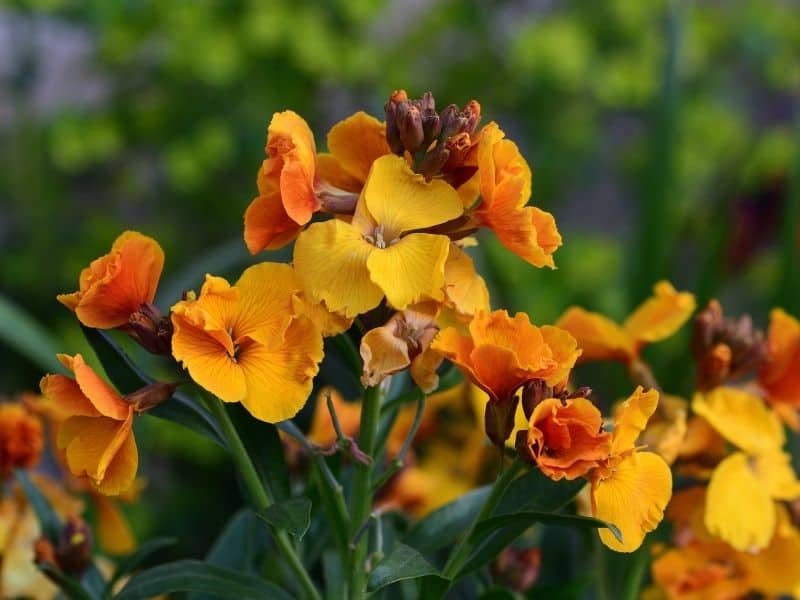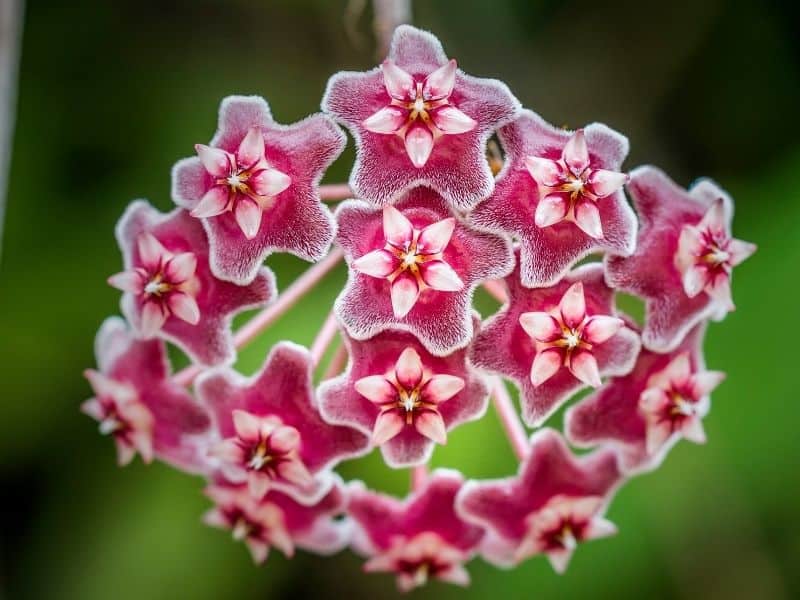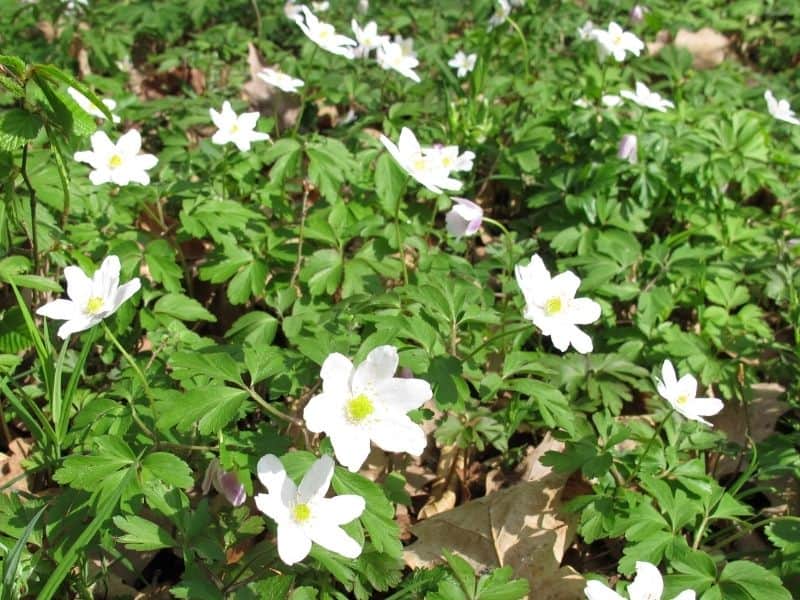Looking to add wow, whimsy, or wonder to your garden? You’ve come to the right place! Browse through this list of wonderful flowers that start with W, and you just might find a few spectacular plants that you’ve never heard of before.

Annual Flowers that Start with W
1. Wishbone flower (Torenia fournieri)

Named for the shape formed by its stamens, wishbone flower blooms in combinations of bright, cheerful colors that also earn it the name clown flower. With both upright and trailing varieties, it works beautifully both in the ground and in containers, especially hanging baskets and window boxes. This long-blooming plant flowers from spring into fall.
Wishbone flower prefers consistently moist, well-draining soil with plenty of organic matter and part shade, though it will tolerate full sun with plenty of moisture.
2. Wood sorrel (Oxalis sp.)

Comprising hundreds of species, wood sorrel varies widely in shape, size, and color — both foliage and flowers. Perhaps most common are O. montana, O. acetosella, and O. stricta, which feature white to reddish flowers, pink-streaked white flowers, and yellow flowers, respectively. The latter two are native to North America. All wood sorrels feature three or four triangular or heart-shaped leaves and dainty, five-petaled flowers.
As suggested by its name, wood sorrel is often a woodland plant, thriving in well-draining soil and part shade, though growing requirements will vary by species.
Perennial Flowers that Start with W
3. Wake-robin (Trillium sp.)

Also called wood lily or simply trillium, wake-robin is easily identified by its three leaves, three sepals, and three petals. This North American woodland native blooms in the spring with lovely, white, lily-like blossoms that turn pink as they age. Seed capsules resembling berries appear after the flowers drop.
Wake-robin thrives in shady locations with humus-rich, moist, well-draining soil.
4. Wallflower (Erysimum sp.)

Like pansies, the cool-season, four-petaled wallflower comes in nearly every color for a bright, striking display. Wallflowers often grow between the stones or bricks of walls, earning them their name, and thus they grow well in rock gardens, raised beds, containers, and borders. Though a short-lived perennial or biennial, the wallflower is often grown as an annual.
Wallflower grows best in dry to medium, well-draining soil, and full sun, with some afternoon shade where summers get hot.
5. Wand flower (Galax urceolata)

Native to southeastern US woodlands, wand flower has shiny, heart-shaped evergreen foliage that often bronzes in the fall and makes a lovely ground cover in shade gardens. A narrow, eight- to 15-inch cluster of small white flowers rises like a wand in late spring or early summer.
Wand flower thrives in dappled to full shade and rich, moist, acidic, well-draining soil.
6. Water lily (Nymphaea sp.)

A classic water plant, water lily provides beauty as well as a host of other benefits to the pond it grows in. Its large leaves shade and cool the water, preventing the growth of heat-loving algae and providing shelter for fish from birds and other predators. Available in both soft pastels and bright jewel tones, the showy flowers bloom during the day in summer and close up at night.
Water lilies should be planted in containers to prevent them from becoming too large and spreading aggressively. They thrive in heavy clay-loam soil.
7. Wax flower (Hoya sp.)

Although often grown as a houseplant, wax flower can be planted outdoors in USDA zones 10 and warmer or in a pot that can be brought inside during the winter in cooler climates. This tropical plant is named for its clusters of small, waxy, white to red flowers that bloom in the summer amid thick, waxy evergreen leaves.
Wax flower should be planted in loose, rich, well-draining soil. When grown in a pot, it actually prefers to be a bit root-bound.
8. Whirling butterflies (Gaura lindheimeri)

The white, four-petaled flowers dancing atop tall, delicate stems give whirling butterflies its name. This North American native also attracts real butterflies as well as hummingbirds during its blooming season from early summer into fall. It grows equally well in borders, wildflower meadows, rock gardens, and containers.
An easy grower, whirling butterflies tolerates heat, drought, dry soils, humidity, and partial shade, though it prefers a sunny location with loamy, sandy, well-draining soil.
9. White wood aster (Eurybia divaricata)

An eastern North American native, white wood aster attracts butterflies with its mass of white, daisy-like flowers that age to pink over the late summer to fall blooming season. This bushy perennial grows one to three feet tall and is perfect for woodland gardens, shady borders, cottage gardens, and slopes.
White wood aster grows best in dry to medium, well-draining soil and part to full shade.
10. Wine cups (Callirhoe sp.)

Also called poppy mallow, wine cups features magenta, cup-shaped flowers in summer. This native, drought-tolerant ground cover is an excellent addition to rock gardens, wildflower meadows, retaining walls, slopes, and cottage gardens. The deeply lobed palmate leaves provide beauty even through the winter in mild climates.
A hardy plant, wine cups thrives in well-draining soil in full sun and will even grow well in dry, rocky conditions.
11. Winter aconite (Eranthis sp.)

Appropriately-named winter aconite blooms so early that its sunny, buttercup-like blossoms can often be seen growing right out of the snow. It doesn’t appeal to rabbits, deer, or rodents, making it perfect for planting in borders, along pathways, and around trees in areas frequently visited by wildlife.
A European woodland native, winter aconite grows best in organically rich, moist, well-draining soil in full sun. Because it blooms and goes dormant before the trees leaf out, it will still receive plenty of sunlight when planted under deciduous trees.
12. Wintersweet (Chimonanthus praecox)

True to its name, wintersweet blooms in mid-to-late winter and into early spring. This Chinese shrub grows up to 15 feet high and produces small, fragrant flowers with striking reddish inner tepals surrounded by delicate pale-yellow outer petals. Its shiny, dark green leaves appear after the flowers and turn yellow in the fall for almost year-round interest.
Wintersweet thrives in full sun and average, well-draining soil. Once established, this low-maintenance plant tolerates drought.
13. Wisteria (Wisteria sp.)

A classic woody vine, wisteria drips with purple, pink, or white flower clusters in spring. It does not tolerate transplanting well and takes many years to begin flowering, but your patience will be well rewarded.
Grow wisteria up fences, arbors, or pergolas, but never against a building, as it can damage siding and gutters. It can also be invasive, so check with your local extension office before planting it, and be prepared for annual spring pruning if you do. Learn more about growing wisteria.
Wisteria grows best in moderately fertile, well-draining soil in a sunny location.
14. Witch hazel (Hamamelis sp.)

Witch hazel, a large, unique shrub, typically blooms in the fall, when few other plants are producing flowers. Its small, golden blossoms feature ribbonlike petals and give off a spicy fragrance. Look for a variety native to North America, such as common witch hazel (H. virginiana) or vernal witch hazel (H. vernalis), which actually blooms in late winter or early spring.
Witch hazel performs best in slightly acidic, loamy, well-draining soil and full sun but will tolerate part shade.
15. Wood anemone (Anemone nemorosa)

In spring, wood anemone turns into a carpet of small, white, starry blossoms. Its ferny, low-growing foliage makes a lovely ground cover in woodland and rock gardens or around trees and large shrubs. Although wood anemone goes dormant in the heat of summer, it also has some drought tolerance during this dormancy.
Wood anemone is easy to grow but prefers moist, humus-rich, slightly acidic, well-draining soil in a shady location.
16. Wood violet (Viola sororia)

Known by many names, such as common blue violet, wood violet can be found growing naturally throughout eastern and central North America. Its bright, blue-purple blossoms (or white, or pink), appear in early spring against a backdrop of glossy, heart-shaped leaves. This lovely wildflower grows well in many garden settings and even has value in the kitchen, where both flowers and leaves can be used to garnish salads, decorate desserts, or make jelly.
Wood violets prefer moderately moist, humus-rich soil and part shade but will tolerate full sun and clay soil.
I hope you’ve enjoyed wandering through the wild, wonderful world of flowers that start with W. Happy planting!




Mary Wilson
Friday 23rd of April 2021
This is beautiful!!! I love it!!!! Thanks!!!!
Beautiful Flower Garden Ideas
Friday 23rd of April 2021
[…] 16 Wonderful Flowers That Start With W […]